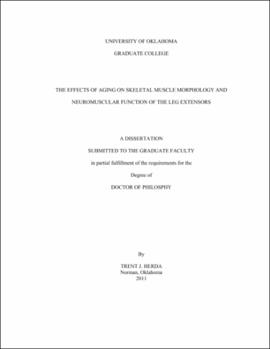| dc.description.abstract | The purpose of the present study was to examine the muscle cross-sectional area (CSA), thigh skinfold thickness (SF), maximal voluntary contraction (MVC) peak force (PF), and the log-transformed EMG and MMG amplitude (RMS)-force relationships (vastus lateralis [VL] and rectus femoris [RF]) of isometric step and ramp muscle actions of the right leg extensors for individuals between the ages of 20-75 years. In addition, myosin heavy chain (MHC) isoform content of the VL was analyzed to characterize individual fiber type composition. Fifty-seven healthy men volunteered for this investigation and were categorized into groups by age: 20-25 (n = 10; mean ± SD age = 22.3 ± 2.5 yrs; stature = 177.5 ±7.3 cm; mass = 82.0 ± 17.2 kg), 30-35 (n = 10; age = 32.3 ± 1.6 yrs; stature = 175.4 ± 6.8 cm; mass = 89.8 ± 13.4 kg), 40-45 (n = 10; age = 42.6 ± 2.3 yrs; stature = 180.0 ± 6.2 cm; mass = 86.7 ± 11.2 kg), 50-55 (n = 8; age = 52. 9 ± 1.9 yrs; stature = 174.8 ± 6.1 cm; mass = 93.6 ± 11.7 kg), 60-65 (n = 9; age = 62.8 ± 2.1 yrs; stature = 175.0 ± 6.3 cm; mass = 83.6 ± 12.1 kg), and 70-75 (n = 10; age = 73.5 ± 2.5 yrs; stature = 171.5 ± 7.2 cm; mass = 80.2 ± 12.8 kg) years of age. Thigh SF measurements were taken from the VL and the mid-thigh muscle CSA, from a peripheral quantitative computed tomography scanner, was taken at the site of MMG electrode placement. Subjects performed two MVCs, nine submaximal voluntary contractions (10, 20, 30, 40, 50, 60, 70, 80, and 90% MVC of the highest pre-testing MVC value) in random order, and two 6-s isometric ramp muscle actions from 10 to 100% of their MVC. Linear regression models were fit to the natural log-transformed EMGRMS and MMGRMS-force relationships. In addition, Bergstrom muscle biopsies were taken from the VL and were analyzed for MHC isoform content. Type I MHC isoform content was higher for the 70-75 (mean ± SD 45.8 ± 5.3%) than the 20-25 age group (37.48 ± 3.94%). For MVC PF, the 20-25 (746.2 ± 305.2 N) and the 30-35 (812.9 ± 230.7 N) age groups were higher than the 70-75 (459.7 ± 223.4 N) age group. Muscle CSA was greater for the 30-35 (190.8 ± 7.9 cm2) than the 60-65 (148.6 ± 20.4 cm2) and 70-75 (140.0 ± 22.1 cm2) age groups and, furthermore, the 40-45 (182.5 ± 43.1 cm2) age group had a greater muscle CSA than the 70-75 age group. There were no age-related differences for SF thickness and a terms from the isometric step and ramp EMGRMS and MMGRMS-force relationships. However, there were muscle-related differences for the a terms (collapsed across age groups), such as, the a terms for the VL were greater than for the RF for the isometric step and ramp EMGRMS and MMGRMS-force relationships (except for isometric ramp MMGRMS-force relationship). For the b terms from the isometric ramp MMGRMS-force relationships, there were differences between the 20-25 (0.60 ± 0.16) and 70-75 (0.32 ± 0.12) age groups, however, there were no other age-related differences for b terms from the isometric step and ramp EMGRMS and MMGRMS-force relationships. In addition, there were muscle-related differences for the b terms from the isometric step and ramp EMGRMS and MMGRMS-force relationships (except for isometric ramp MMGRMS-force relationship). For example, the b terms for the RF were higher than the VL (collapsed across age groups). | |
| dc.description.abstract | The results for the present study indicated that there were no age-related changes for SF thickness and the a terms from the EMGRMS and MMGRMS-force relationships. The a terms (gain factors) have previously reflected differences in subcutaneous fat over the muscle. Therefore, since SF thicknesses were not different amongst the age groups, it is expected that there were no differences in the a terms. However, there were muscle-related differences for a terms, where the VL a terms were higher than the RF. These discrepancies between the a terms were likely the result of subcutaneous fat differences between the muscles with the VL having less subcutaneous fat than the RF. In addition, the results of the present study indicated that that there was an age-related increase in percent type I MHC isoform content with the 70-75 age group having a significantly greater amount of type I MHC isoform content than the 20-25 age group. The b terms from the log-transformed MMGRMS-force relationship from the isometric ramp contractions reflected the MHC isoform content differences between the two groups (20-25 vs. 70-75 age group) since the b terms were lower for the 70-75 age group than the 20-25 age group. There were age-related differences in MVC PF and muscle CSA that did not match the age-related differences in MHC isoform content or the b terms from the MMGRMS-force relationships. Thus, the b terms from the MMGRMS-force relationships reflected differences in motor control strategies between individuals with known type I MHC isoform content differences, but not the age-related in muscle strength or size. For EMGRMS-force relationships, there were no age-related changes for the b terms, which suggested that the EMGRMS-force relationships were unable to distinguish between different motor control strategies, between individuals with known MHC isoform content differences, or among age groups. In conclusion, the log-transformed MMGRMS-force model may be an attractive model to monitor changes in fiber type composition during the aging process when type II fibers are lost. With additional research, the log-transformed MMGRMS-force model may be a useful, noninvasive criterion for the diagnosis of sarcopenia. | |
